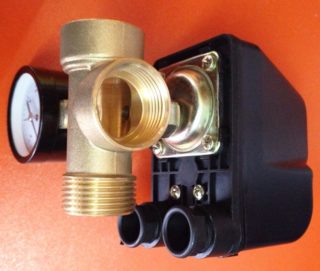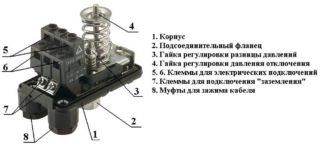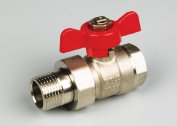As a rule, an autonomous water supply system is the only way to ensure a comfortable stay in a country house. If there is a well on the plot, you can enjoy the taste of crystal clear water, which did not overcome kilometers in the outdated central highway. But sometimes it is problematic to implement the plan, this is due to the large depth of the water reservoir. The pump station will help to solve the problem, an integral part of which is the pressure switch for the accumulator.
What is a pressure switch
To adjust the water pressure switch in the accumulator, you need to familiarize yourself with the principles of operation and device design, as well as the rules for its configuration.
Providing the optimal level of water column in the well shaft allows maintaining constant pressure in the pipeline. Two parts that are attached to the water pump are responsible for this - a pressure switch and a hydraulic accumulator. The relay is a small box in which electrical contacts are placed. The battery for water has a cylindrical shape, designed to store a fixed volume of liquid.
There are several modifications of the pumping equipment. The pump can be installed directly on the accumulator, a pressure switch is already connected to it with the help of an adapter, called a pyaternik. Separately, the pyaternik is equipped with a manometer, its panel displays the pressure inside the system.
The principle of the pump system is that the relay is equipped with contacts that operate when certain pressure levels are reached.
Without a pressure gauge, it is almost impossible to configure the relay for the accumulator. Also, the initial filling of the accumulator with water should be done gradually, otherwise it is likely that the pear (membrane) will be damaged. This is due to the fact that as a result of prolonged storage of liquid, its walls are glued together.
Types of Pressure Switches
There are miniature and fairly dimensional devices. Their difference also lies in equipping with additional functions. The classic relay for the accumulator includes two working units:
- hydraulic;
- electric.
The first is intended for the interaction of the device with the liquid entering it. It is a rod and two springs. Due to the latter, the optimal pressure parameters are adjusted. The main task of the latter is to connect the conductors to electricity. It is a metal terminal with clamping bolts. Depending on the position of the hydraulic part, the terminals open and close.
The following types of pressure switches can be purchased on the market or in specialized stores:
- with dry run sensor;
- mechanical;
- equipped with a built-in pressure gauge;
- electronic.
Electronic relays are equipped with additional modules that open and close contacts. They also have built-in electronic pressure gauges with a digital display. The dry-running sensor warns the pump station to work “idle” if, for example, the water level drops, the intake hole clogs or the feed pipe is damaged.
Pressure Switch Settings
The pressure switch needs to be adjusted during commissioning and after repair, as well as when making changes to the autonomous water supply system. Before setting up, you need to familiarize yourself with the following rules and recommendations:
- To warn all residents of the house that during the repair work it is impossible to use taps, a shower, a toilet and other water folding units.
- Close all taps and check the integrity of all elements of plumbing, pipes, taps, etc. Particular attention should be paid to the toilet flush tank. If it leaks or continues to work, it will be practically impossible to properly adjust the operation of the device.
- A mandatory check is the working air pressure in the water battery. If the performance fluctuates or is below normal, you need to restore the relay to the factory settings.
If difficulties arise during the work, it is better not to experiment, but to consult a specialist. If the entire autonomous water supply system fails, a lot of investment will be required to restore it.
The main task of the relay is to control the minimum and maximum pressure indicators in the storage tank, to maintain the optimum pressure difference when switching on and off the pump station. The limit of acceptable values depends on the power and performance of the installed pump and the hourly flow rate.
The technical data sheet of the equipment indicates all the characteristic features of the factory settings. 1 - 5 atmospheres - standard values for setting pressure switches in water supply systems. Starting performance - 1.5 atmospheres. The parameter for comfortable operation of the pumping equipment engine is 2.5 atmospheres. The maximum pressure at which all equipment is turned off is 5 atmospheres.
If the parameters set by the factory become irrelevant or a malfunction of the system occurs, the settings are made independently using a pressure gauge. This meter is mounted on the accumulator manifold. Correction is carried out, based on the readings of the pressure gauge, after the pumping equipment has turned off. A pressure surge is created by opening a water tap.
Phased adjustment of the water accumulator with pressure switch and pressure gauge
The adjustment is made under pressure, beforehand the pumping station should not be disconnected from the electric power. The pump must fill the entire storage tank with liquid, thereby raising the pressure in the pipeline network. As soon as the relay has tripped and the pump has switched off, it is necessary to remove the plastic cover from the housing and loosen the tension of the small spring to the maximum.

Adjust the relay to the minimum pump start pressure as follows:
- In the process, only a large adjustment spring will be involved.
- The clamping nut must be rotated clockwise, this will increase the starting pressure.
- The weakening of the tightness provides a decrease in the response pressure of the accumulator relay and the inclusion of the pumping equipment motor.
- To check the work performed, open the water tap and drain the water until the pump turns on.
Adjust the accumulator relay according to the pump shut-off pressure according to the following algorithm:
- In the process, only a small adjustment spring will be used.
- To increase the pressure difference, tighten the nut on the small spring stud.
- The weakening of the interference is ensured by lowering the pressure to shut off the pump station engine.
- The result of the changes made to the settings is checked by a test run of the water pump.
If the results of the check show that the pressure gauge reads match the required values for turning the engine on and off, the adjustment is completed.If you could not configure the device yourself, it is better to contact a specialist in these matters or purchase a new relay. If you decide to purchase a new “box”, it’s important when choosing to pay attention to the compatibility of work with an autonomous pump station and how to connect to the electricity network.
The attached instruction manual and setup shows detailed diagrams and descriptions of how to connect and control the relay. Most often, difficulties do not arise.
The lack or absence of air entails the stretching of the membrane and the operation of the equipment with each intake of liquid. Increased pressure reduces the volume of water in the membrane, as well as the interval between operations of the pressure unit. Frequent turning on and off the water pump leads to its overheating, the service life is significantly reduced.
Preventive actions
If the system is malfunctioning and the pressure gauge confirms this, the following preventive measures are taken:
- Parts sensitive to mechanical stresses are checked and, if necessary, adjusted.
- Contacts are recommended to be cleaned.
- If the relay does not work, do not rush to disassemble it, it is better to tap the case with a light object. Specialists note that such manipulation often helps.
- Once a year, the moving parts of the device are lubricated with grease.
- If you tighten and tighten the adjustment nuts, the relay will not work at all. This is a common mistake.
The installation price ranges widely, the minimum cost in all regions of Russia does not exceed 1000 rubles. Electronic modifications are more expensive because they show more accurate data.





